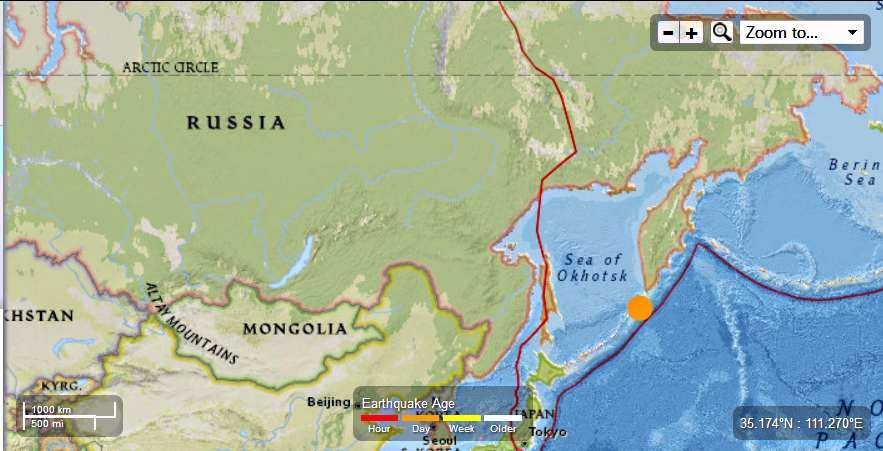Earth watch Report - Earthquakes

...
M5.1 - 120km S of Severo-Kuril'sk, Russia
2013-08-01 16:39:59 UTC

Event Time
- 2013-08-01 16:39:59 UTC
- 2013-08-02 02:39:59 UTC+10:00 at epicenter
- 2013-08-01 11:39:59 UTC-05:00 system time
Location
49.592°N 156.111°E depth=56.5km (35.1mi)Nearby Cities
- 120km (75mi) S of Severo-Kuril'sk, Russia
- 404km (251mi) SSW of Vilyuchinsk, Russia
- 422km (262mi) SSW of Petropavlovsk-Kamchatskiy, Russia
- 429km (267mi) SSW of Yelizovo, Russia
- 2039km (1267mi) NE of Tokyo, Japan
Tectonic Summary
Seismotectonics of the Kuril-Kamchatka Arc
The Kuril-Kamchatka arc extends approximately 2,100 km from Hokkaido, Japan, along the Kuril Islands and the Pacific coast of the Kamchatka Peninsula to its intersection with the Aleutian arc near the Commander Islands, Russia. It marks the region where the Pacific plate subducts into the mantle beneath the Okhotsk microplate, part of the larger North America plate. This subduction is responsible for the generation of the Kuril Islands chain, active volcanoes located along the entire arc, and the deep offshore Kuril-Kamchatka trench. Relative to a fixed North America plate, the Pacific plate is moving towards the northwest at a rate that increases from 75 mm/year near the northern end of the arc to 83 mm/year in the south.Plate motion is predominantly convergent along the Kuril-Kamchatka arc with obliquity increasing towards the southern section of the arc. The subducting Pacific plate is relatively old, particularly adjacent to Kamchatka where its age is greater than 100 Ma. Consequently, the Wadati-Benioff zone is well defined to depths of approximately 650 km. The central section of the arc is comprised of an oceanic island arc system, which differs from the continental arc systems of the northern and southern sections. Oblique convergence in the southern Kuril arc results in the partitioning of stresses into both trench-normal thrust earthquakes and trench-parallel strike-slip earthquakes, and the westward translation of the Kuril forearc. This westward migration of the Kuril forearc currently results in collision between the Kuril arc in the north and the Japan arc in the south, resulting in the deformation and uplift of the Hidaka Mountains in central Hokkaido.
The Kuril-Kamchatka arc is considered one of the most seismically active regions in the world. Deformation of the overriding North America plate generates shallow crustal earthquakes, whereas slip at the subduction zone interface between the Pacific and North America plates generates interplate earthquakes that extend from near the base of the trench to depths of 40 to 60 km. At greater depths, Kuril-Kamchatka arc earthquakes occur within the subducting Pacific plate and can reach depths of approximately 650 km.
This region has frequently experienced large (M>7) earthquakes over the past century. Since 1900, seven great earthquakes (M8.3 or larger) have also occurred along the arc, with mechanisms that include interplate thrust faulting, and intraplate faulting. Damaging tsunamis followed several of the large interplate megathrust earthquakes. These events include the February 3, 1923 M8.4 Kamchatka, the November 6,1958 M8.4 Etorofu, and the September 25, 2003 M8.3 Hokkaido earthquakes. A large M8.5 megathrust earthquake occurred on October 13, 1963 off the coast of Urup, an island along the southern Kuril arc, which generated a large tsunami in the Pacific Ocean and the Sea of Okhotsk, and caused run-up wave heights of up to 4-5 m along the Kuril arc. The largest megathrust earthquake to occur along the entire Kurile-Kamchatka arc in the 20th century was the November 4, 1952 M9.0 event. This earthquake was followed by a devastating tsunami with run-up wave heights as high as 12 m along the coast of Paramushir, a small island immediately south of Kamchatka, causing significant damage to the city of Severo-Kurilsk.
On October 4,1994, a large (M8.3) intraplate event occurred within the subducted oceanic lithosphere off the coast of Shikotan Island causing intense ground shaking, landslides, and a tsunami with run-up heights of up to 10 m on the island.
The most recent megathrust earthquake in the region was the November 15, 2006 M8.3 Kuril Island event, located in the central section of the arc. Prior to this rupture, this part of the subduction zone had been recognized as a seismic gap spanning from the northeastern end of the 1963 rupture zone to the southwestern end of the 1952 rupture. Two months after the 2006 event, a great (M8.1) normal faulting earthquake occurred on January 13, 2007 in the adjacent outer rise region of the Pacific plate. It has been suggested that the 2007 event may have been caused by the stresses generated from the 2006 earthquake.
More information on regional seismicity and tectonics
...
...

No comments:
Post a Comment
Hello and thank you for visiting my blog. Please share your thoughts and leave a comment :)